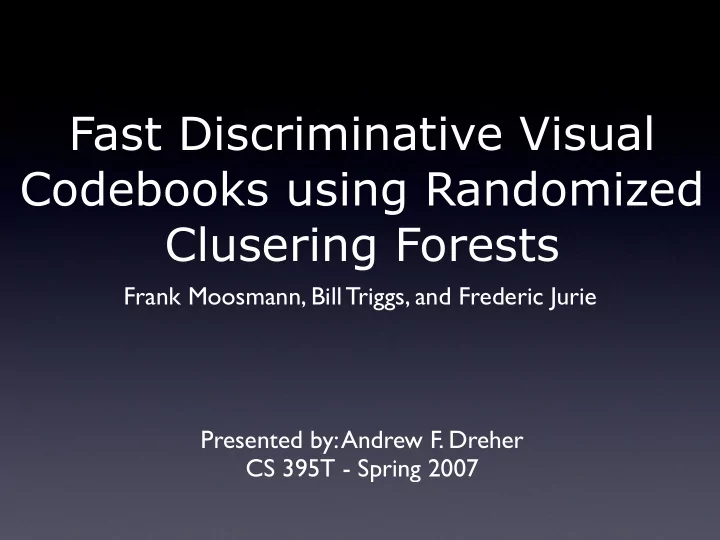

Fast Discriminative Visual Codebooks using Randomized Clusering Forests Frank Moosmann, Bill Triggs, and Frederic Jurie Presented by: Andrew F. Dreher CS 395T - Spring 2007
Contributions 1) Creating visual “words” using classification trees 2) Small ensembles of randomized trees can outperform k-means clustering Using stochasticity to improve accuracy
Trees as “Words”
Visual “Words” 1) High dimensional vectors; typically extracted features or clusters of features summarized at a point 2) Clusters forming is usually performed using k-means clustering 3) Used with “bag of words” methods derived from text processing
Trees as “words” 1) Trees are trained as classifiers 2) Leaves are used as “words” Represent a classified cluster of visual features Provides spacial information and intuition lacking in k-means 3) Classification is a separate stage (using SVM) over the leaves
Information Gain with Entropy 1) Useful with limited number of values 2) Often prefers “pure” nodes Randomization of thresholds helps create different splits and trees Paper parameters S min and T max [0, 1] Completely random trees [1, D] Discriminative trees (classic ID3)
Basic Example of Entropy
Basic Example of Entropy 1
Basic Example of Entropy 2 1 3
Basic Example of Entropy
Experiments
General Overview 1) Descriptors - Dataset dependent HSV color (768-D vector) Wavelet (768-D vector) Created from HSV using Haar transform SIFT (128-D vector) 2) Performance Metrics 1) Receiver Operating Characteristic (ROC) 2) Equal Error Rate (EER)
Haar Wavelet 1) First known wavelet 2) Not continuous or differentiable 3) Described as: { 1 0 ≤ x ≤ ½ f ( x ) = -1 ½ ≤ x ≤ 1 1 0 otherwise Source: Wikipedia (http://en.wikipedia.org/wiki/Haar_wavelet)
Specific Parameters 1) Descriptors: Color Wavelet 2) Tree parameters: S min = 0.5; T max ≈ 50 3) Dataset: GRAZ-02 Three categories 300 Images from each category ½ for training; ½ for testing
Spacial Results Posterior probabilities at a given position to be labeled “bike”
Spacial Results Posterior probabilities at a given position to be labeled “bike”
Category vs. Negative GRAZ-02 Average EER by Category 100 90 80 70 60 50 84.4 84.1 40 79.9 79.8 76.5 70.9 30 20 10 0 Bikes vs. None Cars vs. None Unsegmented Segmented Opelt et. al
Parameters for ERC-Forest vs. K-Means 1) 20,000 total features (only 67 per image) 2) 1000 spacial bins per tree; 5 trees 3) 8000 sampled patches to create global histogram 4) 20,000 windows per image for k-means
ERC-Forest vs. K-Means Bike versus Negative Classification 0.9 ERC-Forest 0.85 K-Means 0.8 Unsupervied Forest + MI 0.75 Binarisation 0.7 Unsupervied Forest 0.65 0.6 100 1,000 10,000 100,000 Number of Features per Image to Create Histogram
Other Results
Pascal Challenge Dataset EER by Category using SIFT Descriptor 100 90 80 70 60 50 96.0 95.8 94.0 90.1 40 30 20 10 0 Motorbikes Bicycles People Cars
Pascal Horses Dataset 1) Highly variable images 2) SIFT Descriptors 3) 100 Patches per image for training 4) 10,000 patches per image for testing 5) Average EER: 85.3%
Conclusion 1) Method uses forest of randomized classification trees to create a vocabulary Good classification, reasonable training 2) Uses two (2) stage processing Use forest to obtain descriptive “word” Classify “word” using another method 3) Stochasticity improves accuracy
Thank You
Recommend
More recommend